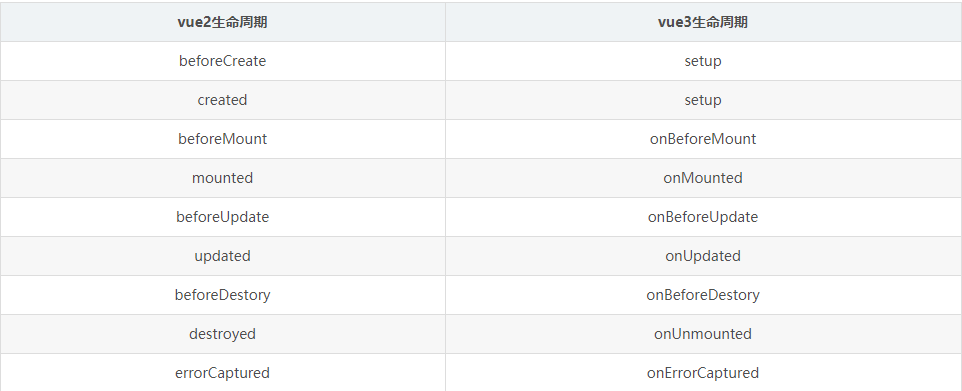vue3.0也出来了很久一段时间了。每次看新闻逛论坛好多都是关于vue3.0的,今天抽空也学习了下,由于是第一次接触,因此查过不少资料,踩过不少坑。特此记录下。
(1)、全局安装最新版本的 @vue/cli npm install -g @vue/cli@next
(2)、使用vite(是一个 web 开发构建工具,由于其原生 ES 模块导入方法,它允许快速提供代码)来快速创建一个vue项目 npm init vite-app <project-name> ,这时候可能报如下错误:

百思不得其解,查资料没查到,想到了很久没有更新node版本,当即去更新了下node版本,然后重新执行如上命令后创建成功了。接下来依次执行如下命令:
cd <project-name> npm install npm run dev
好了,项目终于跑起来了。一个很简单的项目,里面就一个helloworld文件,打开一看,wtf,什么鬼?怎么还是vue2的语法。基本的vue-router也没有包含进去。
好吧,自己动手慢慢搭建吧。首先创建一个hello.vue文件,里面内容如下:
<template>
<div class="wrapper">
hello{{name}}
<h4 @click="test">hello world!</h4>
</div>
</template>
<script>
import { reactive, toRefs, onUpdated, onMounted } from "vue";
import { useRouter } from "vue-router";
export default {
setup() {
const router = useRouter();
// 响应式数据
const state = reactive({
name: "boyjiang"
});
// 页面事件函数
const test = () =>{
state.name = state.name == "江男孩" ? 'boyyang' : '江男孩'
router.push("/helloWorld");
}
onMounted(() => {
console.log('mounted', state.name)
})
onUpdated(() => {
console.log("onUpdated", state.name)
})
// 将数据以及函数return 出去,不然外面是无法访问到数据和事件的
return {
...toRefs(state),
test
}
}
};
</script>
这就完了吗?no,no,no。还得安装vue-router并创建路由文件,否则,项目运行起来是会报错的。
使用命令来安装vue-router: npm install vue-router@next
安装完后在项目的src文件夹下创建router文件夹,然后在该文件夹里创建路由route.js文件,内容如下:
import { createRouter, createWebHistory } from 'vue-router'
const routerHistory = createWebHistory()
const router = createRouter({
history: routerHistory,
routes: [
{
path: '/hello',
component: () => import (/* webpackChunkName: 'Hello' */ '../components/hello.vue')
},
{
path: '/helloWorld',
component: () => import (/* webpackChunkName: 'HelloWorld' */ '../components/HelloWorld.vue')
}
]
})
export default router
修改app.vue文件中的代码如下:
<template>
<div id="app" :style="{'min-height':height + 'px'}">
<div class="hei">{{height}}</div>
<router-view />
</div>
</template>
<script>
import { ref, reactive, toRefs, onMounted} from "vue";
export default {
name: 'App',
setup() {
let state = reactive({
height: window.innerHeight
})
const resize = () => {
state.height = window.innerHeight
}
onMounted(() => {
state.height = window.innerHeight
window.addEventListener('resize', resize)
})
return {
...toRefs(state)
}
}
}
</script>
这样,一个简易的项目就搭起来了。。访问hello文件,里面创建了一个响应式变量,通过点击事件可改变该变量的值,同时会跳转到helloworld文件。
下面来说一下里面用到的一些新特性:
(1)、setup:是专门为使用vue3的composition-api新特性开放的统一入口,执行时机位于beforeCreate 与 created 之间。
(2)、reactive:可以创建多个响应式的数据对象,如const state = reactive({name: "boyjiang"})。
(3)、ref:根据给定的值,创建响应式的数据对象,返回值是一个对象,且只有value,如:const a = ref(0)。
(4)、toRefs:该函数能将reactive创建的响应式对象,转化成为普通的对象,只不过,这个对象上的每个节点,都是ref()类型的响应式数据。
vue3.0生命周期钩子如下:

未完待续,先这样吧,下次有时间再研究下watch,computed以及vuex的用法。